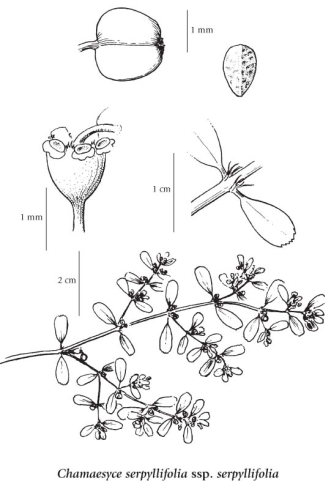thyme-leaved spurge
Euphorbiaceae (Spurge family)
Introduction to Vascular Plants
Map
Distribution of Euphorbia serpyllifolia var. serpyllifolia
Click here to view the full interactive map and legend
Introduction
In North America, this prostrate annual herb is reported from many states and provinces in the US and Canada, but is not reported from northern regions in Canada and from many states in the US southeast (USDA 2011). In BC, it reported from "dry, sandy or gravelly sites in the lowland and steppe vegetation zones; rare on S Vancouver Island and SC BC" (Douglas et al. 1999).
However, Lomer (2011), in his rare plants of the Fraser Valley article, describes it as follows: "A rare prostrate annual that grows along sandy receded pools, pond and lake margins in southwest and south-central BC; not dry sites as reported in most literature. Though the sites may by dry when the plants are mature, this species seems to require saturation during dormancy unlike the similar and common Chamaesyce glyptosperma (Engelm.) Small, which is a weedy species often found along roadsides. In BC C., C. serpyllifolia subsp. serpyllifolia is known from a few lakeshores on Vancouver Island, the Thompson River from Spence's Bridge to Kamloops, Shuswap Lake, and the Okanagan from Osoyoos north to Vaseux Lake. It was found for the first time in the Fraser Valley during the CDC survey in south Langley along a sandy receded lakeshore that was once a gravel pit (UBC: Lomer 6887). About 40 plants were growing with Corrigiola litoralis L., Anagallis minima (L.) Krause, Lindernia dubia (L.) Pennell var. anagallidea (Michx.) Cooperr., and Plagiobothrys scouleri (Hook. & Arn.) I.M. Johnst. In 2010 more than 100 plants were observed at the same site." Extracted from Botanical Electronic News #432, January 2011, with permission. |
Illustration

If more than one illustration is available for a species (e.g., separate illustrations were provided for two subspecies) then links to the separate images will be provided below. Note that individual subspecies or varietal illustrations are not always available.
Illustration Source: The Illustrated Flora of British Columbia
Status Information
Synonyms
Synonyms and Alternate Names:
Chamaesyce serpyllifolia (Pers.) Small
